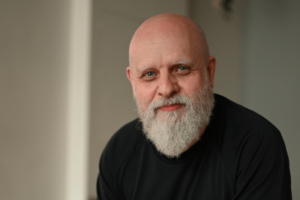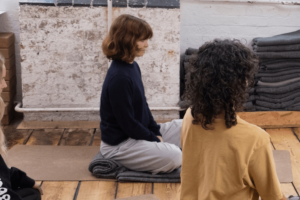The Lowdown on Yin Yoga
What is Yin yoga? What are the benefits? How is it different to a regular flowing yoga class?
We chatted with Austin Ince, one of our amazing online yin yoga teachers, to gain some insight into his Yin Yoga journey and find out some helpful tips for anyone looking to try Yin out!

How did you get into Yin yoga?
I was introduced to yin by my teachers, who had only just discovered it. At the time I was practising lots of dynamic yoga and had plateaued with my practice in terms of flexibility. The ethos of the era was that practising more, for longer and harder must be better. I came to realise that this was seriously flawed thinking! I had come to realise that my practice was out of balance and the idea of practising ‘Yin’ was to balance the predominantly ‘Yang’ element.
What is Yin?
Yin is a still and gentle practice which can be, paradoxically, extremely challenging and hard! Persevere though, not for how you feel during the practice but for how you’ll feel afterwards. The practice is multilayered and creates transformation in more ways than a ‘Yang’ practice. The longer you practise the easier the practice becomes and the less intensively you practice the better the results.
What can you expect from a class?
A yin practice is defined as the opposite of a yang one! In Yin you hold the poses, which in the main are seated and lying down, for longer, between 3 to 5 minutes. It targets the lower part of the body, spine, hips and legs. It applies a gentle tensile stress to the connective tissue and the fascia of the body.

What are the benefits of Yin yoga?
It keeps the tissues, joints, bones healthy and restores the range of motion. The challenge is to stay still and to come to terms with the discomfort and eventually that discomfort becomes comfort. Once they realise that doing less for longer is better, their practice will be transformed. You’ll become more flexible faster practicing yin, if they practice mindfully. Slow is the new fast!
The biggest mistake that practitioners make is that they approach a yin practice with a yang attitude.
When we are in our comfort zone we atrophy, comfort is the enemy of the body and mind. When we leave our comfort zone and experience discomfort, we are challenged, we grow, we become stronger and mentally more agile.
I refer to ‘Yang’ as a doing practice and ‘Yin’ as an undoing practice, “the Art of Letting Go.” Because we are still it becomes a meditative practice, which de-stresses and recalibrated the Central Nervous System.
What would be your advice to those new to the practice?
1. Don’t concern yourself with details – alignment doesn’t matter, what you feel does.
2. Take it easy, don’t go too deep into the poses – you’ll make more progress this way.
3. Ignore what everyone else is doing – every body is different and everyone’s pose will look different.
4. Avoid pain but stay with slight discomfort.
5. Close your eyes and be amazed at how quickly time passes.

So… are you feeling (Y)inspired?
Austin also teaches in our Peckham and Streatham studios. Check our timetable for more info.
